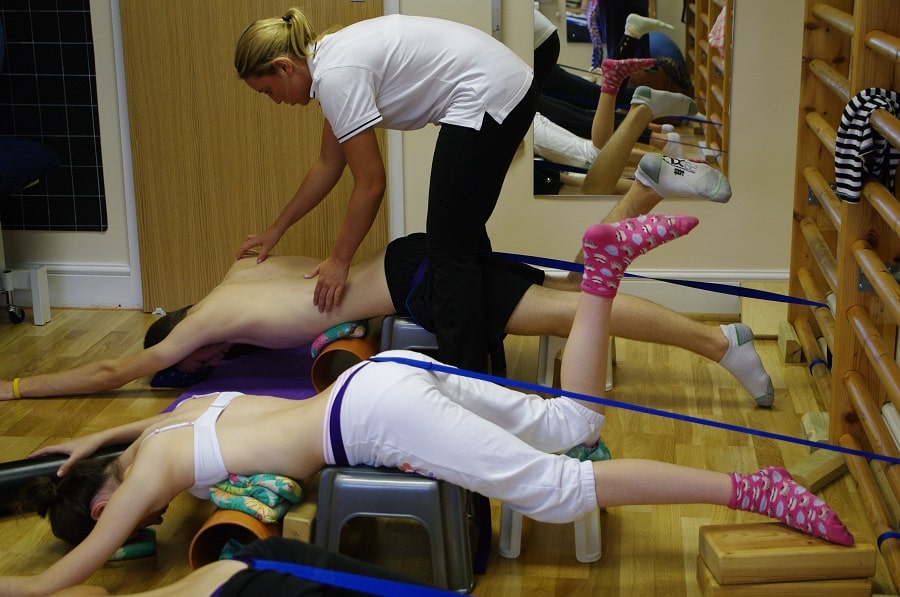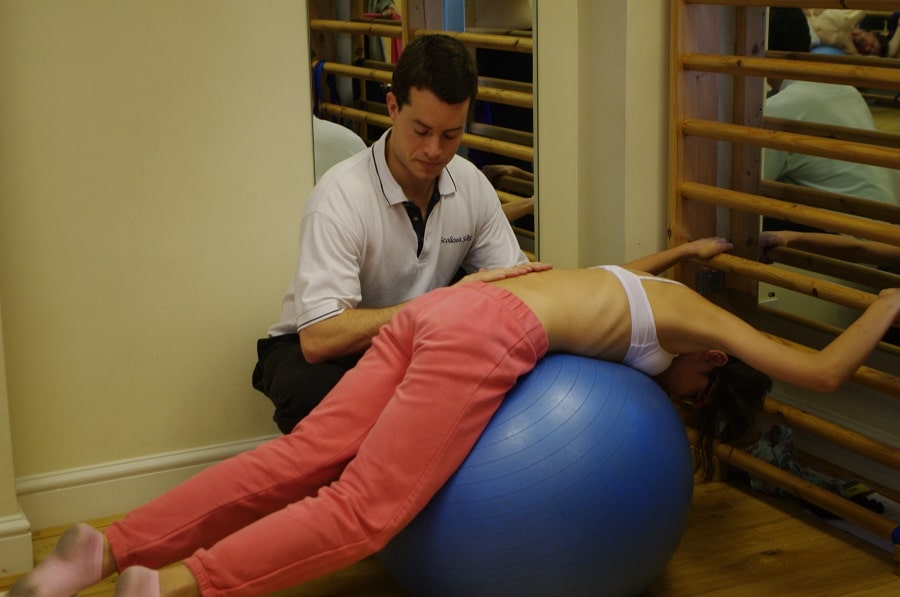
Here at the Scoliosis SOS Clinic, we’ve been successfully treating scoliosis patients for well over a decade. Our comprehensive ScolioGold treatment programme combines a variety of well-known therapeutic techniques, and the exercises that we teach our patients allow them to manage their symptoms and prevent progression from the comfort of their own home.
One of the techniques we use to treat our patients is the Schroth method, in which our therapists our expertly trained.
What is the Schroth method?
The Schroth method is an exercise-based physiotherapy programme that is used to treat scoliosis without surgical intervention. This world-renowned treatment method has helped countless people to improve their posture and overcome the symptoms of scoliosis.
The Schroth method is named after Katharina Schroth, the German physiotherapist who devised it. Schroth herself had a curved spine, and after making great progress with her own condition, she decided to open up a clinic to treat other people with scoliosis.
Katharina Schroth passed away in 1985, but her daughter Christa Lehnert-Schroth continued her work and the Schroth method is now used as physical therapy for scoliosis patients all over the world.
How does the Schroth method help people with scoliosis?
The Schroth method uses stretches and exercises to develop the inner muscles of the rib cage in order to correct spinal abnormalities in all three planes of the body. This treatment method also places emphasis on the conscious correction of posture during day-to-day life.

The Schroth-based exercises that we use here at the Scoliosis SOS Clinic are customised to each patient’s unique spinal curvature, as well as their age and physical ability. Our use of the Schroth method has allowed 88% of our patients to avoid the need for spinal fusion surgery. We also:
- Use a specific rotational breathing technique to correct spinal rotation and increase the patient’s lung capacity
- Rebalance the patient’s spinal position using pelvic corrections and isometric contractions
- Make patients more aware of their posture on a daily basis, ensuring they have the correct equipment at home and at school/work to maintain their corrected position
If you seek these improvements for yourself or someone you love, consider receiving Schroth physical therapy as treatment for scoliosis.
Book a Consultation >
Examples of Schroth method exercises
Here are just a few of the stretches and exercises that make up the Schroth method:
1. Prone on stool
One of the core Schroth exercises, performed in a prone position facing towards the floor. Depending on the patient’s classification, condition, previous medical history and symptoms, this exercise has the potential to correct:
- A thoracic curve using shoulder traction, shoulder counter-traction and the de-rotation breathing technique
- A lumbar curve via activation of the iliopsoas muscle
With a different setup, it can also be used to help thoracolumbar curves.

This exercise requires quite a few pieces of equipment including tubes, stools, belts, straps, beanbags and wedges. Watch our patient Isobel perform this exercise during a check-up appointment at the Scoliosis SOS Clinic:
2. Semi-hanging
This primary Schroth exercise uses gravity to stretch out the spine and relieve pressure on vertebral joints. At the same time, the patient will be applying the rotational breathing technique to flatten the prominent areas of their back, activating their muscles on exhalation to train their body to remember the corrected position when they stop exercising.

This is often used as a preparation exercise at the beginning of a treatment session. A set of wall bars (or equivalent) is necessary to perform this exercise effectively.
Watch our patient Nicole, who travelled from Ghana to the UK for scoliosis treatment, practise this exercise with her therapist:
3. Iliopsoas on a ball
This is a very patient-specific Schroth exercise that is only suitable for someone with a lumbar or thoracolumbar curve. It works by utilising the activation of the iliopsoas muscle to help de-rotate the affected portion of the patient’s spine. This is one of the simpler Schroth method exercises, requiring only a gym ball and wall bars (or equivalent).

Here at the clinic, patients often receive assistance from the therapists using myofascial release techniques to ‘mobilise’ the spine and help the patient to achieve a straight posture in standing.
Watch our patient Molly from Suffolk perform this exercise:
The Schroth component of our ScolioGold therapy course places huge emphasis on conscious correction of posture throughout daily life, not just during exercise therapy. Education is paramount – throughout your 4-week course, our therapists will help you to learn about scoliosis and your body to ensure that you can recognise an abnormal posture and correct it accordingly.
More Scoliosis Exercises >
What is the Rigo-Schroth method?
The Rigo-Schroth method is a modification of the Schroth method. Devised in the 1980s by a Spanish practitioner named Dr Manuel Rigo, it is based on much the same regime of stretches as the Schroth method itself; however, the Rigo-Schroth method is structured differently, with significantly more emphasis on the role of the therapist.
Combining Schroth method exercises with other treatment techniques
Back when we first opened our clinic, our treatment courses were entirely based on the Schroth method. As years passed, however, we noticed that some aspects of scoliosis were not addressed by Schroth scoliosis treatment alone. So, to ensure that all aspects of each patient’s condition are fully treated, we’ve combined the Schroth and Rigo-Schroth methods with a number of other exercise-based / non-surgical treatment to help provide our patients with a fully comprehensive treatment package.
Our Treatment Methods >
This approach has yielded superb results: our treatment courses have proved capable of preventing progression, improving posture and cosmetic appearance, reducing pain, improving quality of life, and reducing the patient’s Cobb angle by up to 20 degrees.
To enrol on one of our Schroth-based scoliosis treatment courses, contact us online or give us a call on 0207 488 4428.
Further reading
